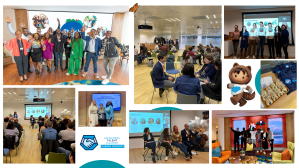How to Promote Gender Equality in the Workplace



Learn how businesses can empower women to continue their careers after the pandemic and support gender equality in the workplace.
Salesforce EMEA
The lack of gender equality in the workplace existed long before COVID-19. Yet, the pandemic has further amplified gender inequities in the workplace.
Many women are trying to balance childcare and teaching their children while working from home.
According to McKinsey’s ‘Women in the Workplace 2020’ report, one in four women considered downshifting their careers or leaving the workforce altogether, seeing no other alternative.
As the world begins to recover from the pandemic, what steps can businesses take to empower women to continue their careers?
In the fourth episode of Salesforce’s Resilience Recast five-part podcast, in partnership with Reuters, host Nisha Pillai was joined by Pip Marlow, CEO of ANZ & ASEAN, Salesforce, and Prof. Barbara Petrongolo, Professor of Economics, University of Oxford.
Gender equality in the workplace should be a top priority
Most organisations understand the importance of gender equality in the workplace. Especially with a health crisis that seems to have highlighted a diversity crisis. So it’s crucial that business leaders understand that they have a big part to play.
Gavin Patterson, President and Chief Revenue Officer at Salesforce, explained why having diverse teams get better results.
“A team that reflects your customer base, with different thinking styles and different experiences, gets better outcomes,” he said. “As leaders, it’s imperative that we focus on building that type of diversity in our organisation.”
How the pandemic has widened gender inequalities
Barbara Petrongolo discussed how the gender inequalities seen in the UK during the COVID-19 pandemic have differed from previous recessions which have typically hit men harder. These downturns largely impacted male-dominated industries like construction and manufacturing.
But now the COVID-19 pandemic’s enforcement of social distancing has had significant repercussions for sectors such as retail and leisure. These sectors, she explained, employ a much higher share of women.
In terms of finances, Barbara’s research in the UK found that men and women experienced similar levels of earnings losses. Moreover, women with children experienced higher losses than women who did not have children. Mothers were also more likely to have lost their jobs than fathers.

Globally, the crisis also impacted heavily on the total volume of childcare and domestic work.
“This of course matters for gender gaps because women provide the most childcare,” said Barbara. “They seem to bear the entire earning penalty associated with childcare.”
Pip Marlow also reflected on the pandemic’s differing impact on men and women.
She explained, “In Australia and New Zealand, we saw about 8% of women lose their jobs compared to 4% of men. We also saw immense pressure on women at the frontline, such as nurses, teachers, and cleaners.”
The future of women and gender equality in the workplace
According to Barbara, women appear to have taken on much of the unpaid labour in terms of childcare and domestic work since the beginning of the pandemic.
Should there be repeated waves of the virus in the future, how many women will end up permanently leaving their jobs? Not only will this affect gender equality in the workplace, but it will also have a substantial impact on the economy.
When it comes to the future of work, most of us will likely shift to a more hybrid way of working. For instance, splitting our time between working in an office and from home. It’s hard now to argue that certain jobs can only be done from an office when this has been the case for so many employees over the past year or so.

But will men and women view the future of working arrangements differently?
“We must establish if there really is a value of being in the workplace and being with your colleagues,” said Barbara. “Does this really fit in with your career prospects? If one is talking about gender inequalities, it’s really about occupational choice and different rates of promotion and different rates of career progress.”
Pip explained how Salesforce is pioneering new, more flexible ways of working all over the world. Some employees can work from home, while others prefer working part-time office hours. In some cases, employees might only need to visit the office once a month.
She explained that the company is exploring how to help people do their jobs in different ways. The goal is to create transparency and accountability between teams.
The need to prevent a two-speed workforce
Many businesses want to provide greater flexibility and gender equality in the workplace. However, there are a few things to be aware of when trying to create an inclusive and flexible work environment.
Pip explained that there is a potential risk of creating a two-speed workforce where women work from home because of childcare and domestic responsibilities, and men work from the office.
“I think it’s really important that we don’t fall into a gender-based work model,” Pip explained. “If what is valued is being at the office, we are going to take what we had before and make it worse. Because suddenly, women will feel the pressure even more to do the unpaid work that is needed and valued at home.”
Business’ role in advocating for sustainable support for parents
If business is to be the greatest platform for change, Pip explained, companies need to make sure that they women bring women into the workforce. They also need to engage with governments to advocate for more sustainable support for parents. Many caregivers lack access to affordable and universal childcare.
Australia, Pip explained, is now approximately the fourth most expensive country in the world to access childcare. So if it’s too difficult or expensive to do that, there’s a greater chance women will stay at home.
If we’re going to normalise women in the office, Pip added, we also have to normalise men at home. This means encouraging parental leave and supporting men to undertake flexible working arrangements.
Creating gender equality in the workplace
Reflecting on what it means to be resilient, Pip said it’s about your ability to recover quickly. To build a better workplace, we need to make it more welcoming and more equitable for everybody.
We also have to embrace learning and some failure on the path to greater resilience and greater sustainability, Pip concluded. “Culturally, we need to find ways for safe learning that allow us to share our losses and challenges and build our losses and resilience. As a leader, being able to do that safely would be one of the best gifts I could give to the organisation, to make everybody more resilient.”
Listen to the ‘Rise of Women’ episode to hear more about how organisations can empower women to continue in their careers post-pandemic.





















